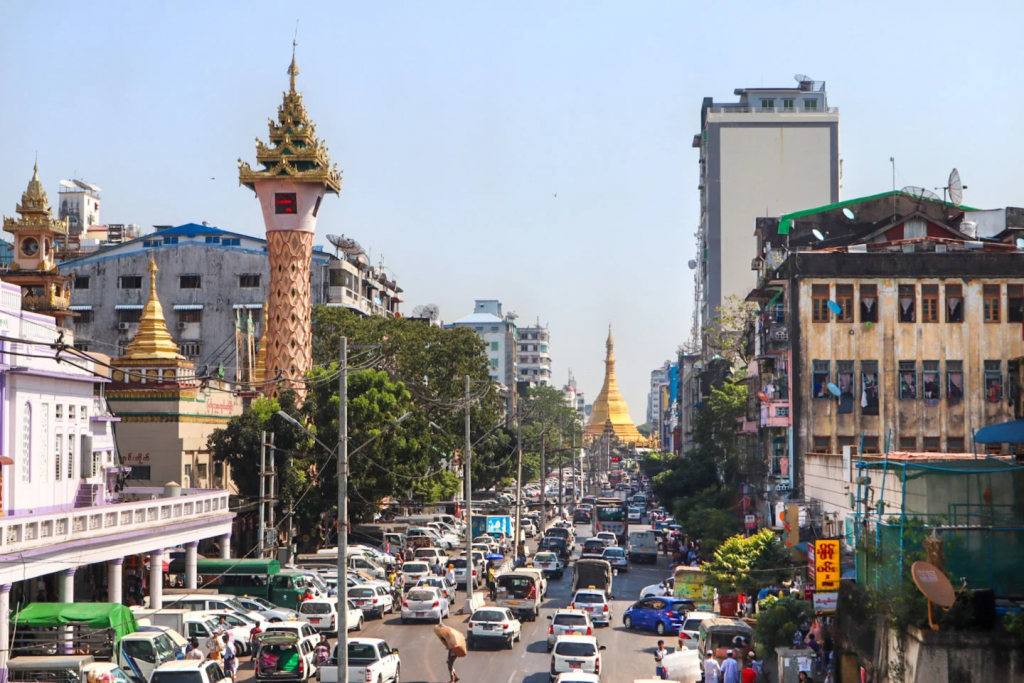When people think of Myanmar, Mandalay is a name that often pops up. Travelers know it for its world-famous U Bein Bridge, where breathtaking sunset photos are a must. Long-term residents recognize it as a hub for the local Chinese community, earning it the nickname “瓦城” (Wa City). Even news watchers might be familiar with Mandalay, as it plays a crucial role in China’s Belt and Road Initiative. But as Myanmar’s second-largest city, what is Mandalay really like? Surprisingly, it feels more like a sprawling town than a bustling metropolis. Let’s take a closer look at this intriguing city.
A City That Defies Expectations
If you’ve spent time in Yangon, arriving in Mandalay can be a bit of a shock. Yangon, though chaotic, still has the hallmarks of a major city—towering buildings, heavy traffic, and vibrant commercial activity. Mandalay, on the other hand, feels different. Skyscrapers are almost nonexistent, and most buildings are only two or three stories tall, lining the streets in an almost suburban fashion. You might wonder why prime real estate on main roads isn’t used for high-rises. As Myanmar’s second-largest city, shouldn’t Mandalay look more modern?

The absence of high-rises is so pronounced that when we first arrived, we didn’t even realize we had entered the city. We were expecting a skyline, but instead, we were met with modest buildings and wide roads. Only when we spotted a sign welcoming us to Mandalay—next to a traditional Burmese gate with golden roofs and white walls—did we believe we had truly arrived.
The Mystery of the Missing City Center
One of our biggest surprises came when trying to locate the city center. In most cities, the downtown area is unmistakable—tall buildings, bustling streets, and non-stop commercial activity. Yet, as we wandered through Mandalay, we kept wondering, “Where’s the city center?” Eventually, we asked a local friend, and his response floored us: “You’ve been in the city center the whole time!” That was a moment of realization—Mandalay simply doesn’t follow the usual city blueprint.
Traffic and Roads: A Pleasant Surprise
While Mandalay lacks skyscrapers, it does have well-maintained roads. Traffic flows smoothly, and despite the presence of motorcycles, congestion is rare. Unlike Yangon, where motorcycles are banned in the city center, Mandalay’s streets are filled with them, adding a lively energy to the roads. The city’s road network is also remarkably well-planned, with a neat grid-like pattern that makes navigation easy. If you have OCD, you might find its clean-cut layout oddly satisfying, while those with trypophobia might feel uneasy!
A Clean but Less Green City
Mandalay’s streets stand out for their cleanliness. Unlike Yangon, where street vendors and large trees often take up sidewalk space, Mandalay’s streets are clear and orderly. However, this comes at a cost—there’s less greenery. In Yangon, tree-lined roads offer welcome shade, but in Mandalay, you’ll struggle to find a leafy refuge from the sun. This lack of greenery is even noticeable on satellite maps, where Mandalay appears more concrete-heavy compared to Yangon’s lush cityscape.
A City with a Strong Chinese Influence
Mandalay is known for its significant Chinese population. Many locals refer to it as “Wa City,” a nickname that has spread even among overseas Chinese communities. Before arriving, we had imagined a city filled with Chinese signs and businesses, where Mandarin was widely spoken. However, walking through the streets, we were surprised by the lack of Chinese signage—most signs were in Burmese, with Chinese and English appearing only occasionally.
Despite this, we frequently heard about Mandalay’s thriving Chinese community from locals and fellow travelers. It seems that for long-term residents, making Chinese-speaking friends and finding Mandarin-speaking areas might be easier, but as short-term visitors, we didn’t get to experience this side of the city fully.
The Charm of a Relaxed City
Mandalay might not have the dazzling skyline of a major city, but it offers a unique charm—clean streets, a well-structured road network, and a laid-back atmosphere. There’s no overwhelming sense of urban pressure, no constant honking from traffic jams, and no suffocating crowds. If Yangon’s fast pace tires you out, Mandalay might feel like a breath of fresh air.
Could this slower pace of life win you over? Could spending more time here reveal a city where you can comfortably use Mandarin and connect with its Chinese community? That’s a question only experience can answer. But one thing is certain—Mandalay is a city that challenges expectations in the most fascinating ways.

No comments yet.